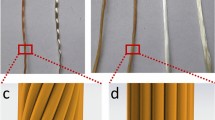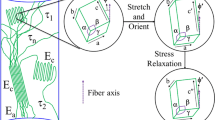Abstract
Regenerated cellulosic fibres undergo a process described as scission-reordering during hydrolysis in solutions of mineral acid. This occurs within disordered polymer regions at lateral crystal interfaces, which are accessible to aqueous agents through the pore spaces and polymer free volume. This process is distinct from that of oligomer-solubilsation, which occurs within disordered polymer regions in series between crystal domains, where no effective template exists for recrystallisation. The degradation of series disorder will have the greatest influence on fibre tensile properties, which fall dramatically even at low levels of hydrolysis. The mechanics of fibrillation are most sensitive to the degradation of lateral disorder, which occurs at a higher rate constant. Soft-touch fabric processing may therefore be possible under conditions where there is a reduced influence on tensile performance. A kinetic model has been proposed to describe the hydrolysis and recrystallisation pathways, which shows that lyocell has longer but thinner crystal domains than viscose or modal fibres, and also a tighter distribution of lateral crystal sizes. Lyocell also has a lower proportion of series disorder and also thinner regions of lateral disorder. This is consistent with the overall greater crystallinity of the original lyocell fibre and the also of the final microscrystalline product.












Similar content being viewed by others
References
Bertran MS, Dale BE (1986) Determination of cellulose accessibility by differential scanning calorimetry. J App Pol Sci 32:4241–4253
Battista OA (1950) Hydrolysis and crystallisation of cellulose. Ind Eng Chem 42:502–507
Calvini P (2005) The influence of levelling-off degree of polymerisation on the kinetics of cellulose degradation. 12:445–447
Cao Y, Tan H (2005) Study on crystal structures of enzyme-hydrolysed cellulosic materials by X-ray diffraction. Enzyme Microb Technol 36:314–317
Cullity BP, Stock SR (2001) Elements of X-ray diffraction. Prentice Hall, NY chapters 5 and 14
Cumberbirch R, Mack C (1960) A quantitative theory of the loss of strength by regenerated cellulose filaments on hydrolysis by acid. Textile Res J 29:T382–389
Cumberbrich R, Mack C (1961) The degree of polymerisation and its distribution in cellulose rayons. Part X – Theory of tenacity and breaking extension of regenerated cellulose filaments. Textile Res J (32):T458–483
Crawshaw J, Cameron RE (2000) A small angle X-ray scattering study of pore structure in Tencel cellulose fibres and the effects of physical treatments. Polymer 41:4691–4698
Eichhorn SJ, Young RJ, Davies GR (2005) Modelling crystal and molecular deformation in regenerated cellulose fibres. Biomacromolecules 6:507–513
Emsley AM, Stephens GC (1994) Kinetics and mechanism of the low-temperature degradation of cellulose. Cellulose 1:26–56
Emsley AM, Heywood RJ, Ali M, Eley CM (1997) On the kinetics of degradation of cellulose. Cellulose 4:1–5
Fengel D, Stoll M (1989) Crystals of cellulose grown from TFA solution. Wood Sci Technol 23:85–94
Hakånsson H, Ahlgran P, Germgård U (2005) The degree of disorder in hardwood kraft pulps studied by means of LODP. Cellulose 12:327–335
Heiner AP, Kuutti L, Teleman O (1998) Comparison of the interface between water and four surfaces of native crystalline cellulose by molecular dynamics simulations. Carbohydrate Res 306:205–220
Hermans PH, Weidinger A (1949) Changes in crystallinity upon heterogeneous acid hydrolysis of cellulose fibres. J Pol Sci IV:317–322
Hofmann, Fink H-P, Philipp B (1988) Lateral crystallite size and lattice distortions in cellulose II samples of different origin. Polymer 30:237–241
Ibbett RN, Fasching M, Domvoglou D (2007) Characterisation of the supramolecular structure of chemically and physically modified cellulosic fibres by means of high-resolution carbon-13 solid-state NMR. Polymer 48:1287–1296
Jayme G, Roffael E (1999) Über dir anderungen der aöntgenkristallinität bei der heterogenen hydrolyse der cellulose. Das Papier 23(1):1–7
Jianchin Z, Meiwu S, Zhu H, Kan L (1999) Study of the skin-core structure of lyocell staple fibers. Chem Fibers Int 49:496–500
Kaehnthong S, Phillips DAS, Renfrew AHM, Wilding MA (2005) Colouration Technol 210(6):316
Kolpak FJ, Blackwell J (1976) Determination of the structure of cellulose II. Macromolecules 9(2):273–278
Lenz J, Schurz J, Wrentschur E (1988) The length of the crystalline domains in fibres of regenerated cellulose. Determination of the crystallite length of cellulose II by means of wide-angle X-ray diffraction and transmission electron microscopy. Holzforschung 42(2):117–122
Lenz J, Esterbauer H, Sattler W, Schurz J, Wrentschur E (1990) changes in the structure and morphology of regenerated cellulose caused by acid hydrolysis. J Appl Pol Sci 41:1315–1326
Lenz J, Schurz J, Wrentschur E (1992) Comparative characterisation of solvent spun cellulose and high wet modulus viscose fibres by their long periods. Acta Polymer 43:307–312
Fink H-P, Weigel P, Purs HJ, Ganster J (2001) Prog Polym Sci 26:1473
Maier G, Zipper P, Stubičar Schurz J (2005) Amorphization of different cellulose samples by ball milling. Cellulose Chem Technol 39(3–4):167–177
Mak CM, Yuen CWM, Ku SKA, Kan CW (2006) Changes in surface morphology of Tencel fabric during the fibrillation process. J Textile Institute 97(3):241–246
Mascia S, Patel MJ, Rough SL, Martin PJ, Wilson DI (2006). Liquid phase migration in the extrusion and squeezing of microcrystalline cellulose pastes. Eur J Pharmaceutical Sci 29:22–34
Nelson ML, Tripp VW (1953) Determination of the levelling-off degree of polymerisation of cotton and rayon. J Pol Sci 10(6):577–586
Newman RH, Hemmingson JA (1995) Carbon-13 NMR distinction between categories of molecular order and disorder in cellulose. Cellulose 2:95–100
Nevell TP (1983) Acid and alkali reactions of cellulose. In: Nevell TP, Zeronian SH (eds) Cellulose chemistry and its applications. Ellis Horwood Ltd, UK
Paralikar KM, Aravindanath S (1988) Crystallisation of cellulose. J Appl Pol Sci 35:2085–2089
Phillip HJ, Nelson ML Ziifle HM (1947) Crystallinity of celllose fibres as determined by acid hydrolysis. Textile Res J 17(11):585–596
Sarko A, Stipanovic AJ (1976) Packing analysis of carbohydrates and polysaccharides. 6. molecular and crystal structure of regenerated cellulose II. Macromolecules 9(5):851–857
Segal L, Creely JJ, Martin AE, Contrad CM (1959) An empirical method for estimating the degree of crystallinity of native cellulose using the X-ray diffraction. Textile Res J 29:786–794
Sharples A (1954) The hydrolysis of cellulose part 1. The fine structure of Egyptian cotton. J Pol Sci 13:393–401
Sharples A (1957) The hydrolysis of cellulose and its relation to structure. Trans Faraday Soc 53:1003–1014
Sharples A (1958) The hydrolysis of cellulose and its relation to structure, Part 2. Trans Faraday Soc 54:913–917
Shlieout G, Arnold K, Müller G (2006) Powder and mechanical properties of microcrystalline cellulose with different degrees of polymerization. AAPS PharmSciTech 2002; 3(2) article 11 (http://www.aapspharmscitech.org)
Steinfeld JI, Fransciso JS, Hase WL (1989) Chemical kinetics and dyanics. Prentice Hall, Englewood Cliffs, NJ
Taylor JM, Briggs NP (2002, 2004) Patents, WO 02/103104, WO2004/079082
Torget RW, Kim JS, Lee YY (2000) Fundamental aspects of dilute acid hydrolysis/fractionation kinetics of hardwood carbohydrates. 1 cellulose hydrolysis. Ind Eng Chem Res 29:2817–2825
Vickers ME (1995) Wide-angle X-ray diffraction of polymers. In: Richards RW (ed) Scattering methods in polymer science. Ellis Horwood Ltd
Vickers ME, Briggs NP, Ibbett RN, Payne JJ, Smith SB (2001) Small angle X-ray scattering studies on lyocell cellulosic fibres: the effects of drying, re-wetting and changing coagulation temperature. Polymer 41:8241–8248
Wadehra IL, Manley RstJ (1965) Recrystallization of amorphous cellulose 9:2627–2630
Wood BF, Conner AH, Hill Jr CG (1989) The heterogeneous character of the dilute acid hydrolysis of crystalline cellulose. J App Pol Sci 37:1373–1394
Zu X, Uesaka TM, Gurnagul N (1996) Prediction of paper permanence by accelerated aging I: Kinetic analysis of the ageing process. Cellulose 3:243–267
Acknowledgments
Dr Andy Banks, Mr J. A. Taylor and The Lenzing AG, The authors are grateful for financial support from Christian Doppler Society.
Author information
Authors and Affiliations
Corresponding author
Rights and permissions
About this article
Cite this article
Ibbett, R.N., Domvoglou, D. & Phillips, D.A.S. The hydrolysis and recrystallisation of lyocell and comparative cellulosic fibres in solutions of mineral acid. Cellulose 15, 241–254 (2008). https://doi.org/10.1007/s10570-007-9157-5
Received:
Accepted:
Published:
Issue Date:
DOI: https://doi.org/10.1007/s10570-007-9157-5




